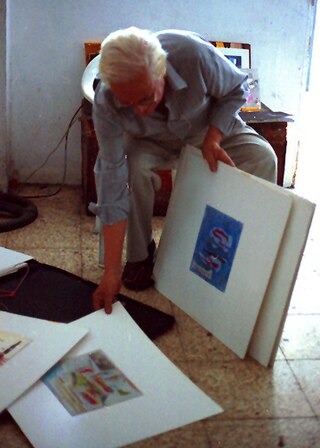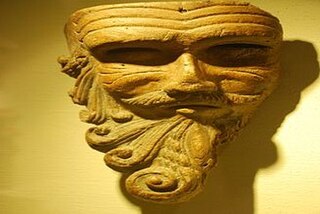
The Taos art colony was an art colony founded in Taos, New Mexico, by artists attracted by the culture of the Taos Pueblo and northern New Mexico. The history of Hispanic craftsmanship in furniture, tin work, and other mediums also played a role in creating a multicultural tradition of art in the area.

Diego María de la Concepción Juan Nepomuceno Estanislao de la Rivera y Barrientos Acosta y Rodríguez, known as Diego Rivera, was a prominent Mexican painter. His large frescoes helped establish the mural movement in Mexican and international art.

Georgia Totto O'Keeffe was an American modernist painter and draftswoman whose career spanned seven decades and whose work remained largely independent of major art movements. Called the "Mother of American modernism", O'Keeffe gained international recognition for her meticulous paintings of natural forms, particularly flowers and desert-inspired landscapes, which were often drawn from and related to places and environments in which she lived.

Alfred Stieglitz was an American photographer and modern art promoter who was instrumental over his 50-year career in making photography an accepted art form. In addition to his photography, Stieglitz was known for the New York art galleries that he ran in the early part of the 20th century, where he introduced many avant-garde European artists to the U.S. He was married to painter Georgia O'Keeffe.

The Palacio de Bellas Artes is a prominent cultural center in Mexico City. This hosts performing arts events, literature events and plastic arts galleries and exhibitions. "Bellas Artes" for short, has been called the "art cathedral of Mexico", and is located on the western side of the historic center of Mexico City which is close to the Alameda Central park.

Kemper Museum of Contemporary Art opened in 1994 in Kansas City, Missouri. With a $5 million annual budget and approximately 75,000 visitors each year, it is Missouri's first and largest contemporary museum.

Luis Enrique Tábara was a master Ecuadorian painter and teacher representing a whole Hispanic pictorial and artistic culture.

The Georgia O'Keeffe Museum is dedicated to the artistic legacy of Georgia O'Keeffe, her life, American modernism, and public engagement. It opened on July 17, 1997, eleven years after the artist's death. It comprises multiple sites in two locations: Santa Fe, New Mexico, and Abiquiu, New Mexico. In addition to the founding Georgia O'Keeffe Museum in Santa Fe, the O'Keeffe includes: the Library and Archive within its research center at the historic A.M. Bergere house; the Education Annex for youth and public programming; Georgia O'Keeffe's historic Abiquiu Home and Studio; the O'Keeffe Welcome Center in Abiquiu; and Museum Stores in both Santa Fe and Abiquiu. Georgia O'Keeffe's additional home at the Ghost Ranch property is also part of the O'Keeffe Museum's assets, but is not open to the public.

Francisco Benjamín López Toledo was a Mexican Zapotec painter, sculptor, and graphic artist. In a career that spanned seven decades, Toledo produced thousands of works of art and became widely regarded as one of Mexico's most important contemporary artists. An activist as well as an artist, he promoted the artistic culture and heritage of Oaxaca state. Toledo was considered part of the Breakaway Generation of Mexican art.

The Modern Art Museum of Fort Worth is an art museum of post-World War II art in Fort Worth, Texas with a collection of international modern and contemporary art. Founded in 1892, The Modern is located in the city's cultural district in a building designed by architect Tadao Ando which opened to the public in 2002. The museum is accredited by the American Alliance of Museums and holds a permanent collection with more than 3,000 works of art.

Rafael Coronel was a Mexican painter. He was the son-in-law of Diego Rivera.
Cundo Bermúdez, born Secundino (Cundo) Bermúdez y Delgado, was a Cuban painter. Born in Havana, Cuba, he died of a heart attack in his Westchester home on October 30, 2008.
Jorge Noceda Sánchez was Dominican-born American diplomat, and painter. His surrealist artwork has been collected by international museums. He also worked as a gastroeonerolgist, and a dog breeder.

Gustav Waldemar Sjölander Johnson was a Swedish painter, printmaker and sculptor, who developed most of his career in Mexico. He immigrated to the country just after World War II, after establishing himself as an artist in his native Sweden. His career included individual exhibitions in venues such as the Palacio de Bellas Artes in Mexico and the Konstakademin in Sweden, with his works held by museums in Mexico and Europe.
Javier Arevalo was a contemporary Mexican artist whose work was the subject of many exhibitions, worldwide, including in Europe, Latin America, United States, Mexico and Japan. His influence was greatest in Mexico City, and Guadalajara, Jalisco. He also taught Art at the Palacio de Bellas Artes in Mexico City.

Todd Webb was an American photographer notable for documenting everyday life and architecture in cities such as New York City, Paris as well as from the American west. He traveled extensively during his long life and had important friendships with artists such as Berenice Abbott, Walker Evans, Alfred Stieglitz, Georgia O'Keeffe, Ansel Adams, Dorothea Lange, and Harry Callahan.
José García Narezo was a Mexican painter and a founding member of the Salón de la Plástica Mexicana.
Olga Dondé was a Mexican artist involved in various fields but best known her still life pieces. She was a self-taught painter, who worked for two years until she decided to enter works in a show in 1968. From then she had about 100 showings of her work, including more than forty individual exhibitions in Mexico, the United States, South Americana and Europe. She also founded artistic organizations, an art gallery and a publishing house. Dondé’s work was recognized by admission in the Salón de la Plástica Mexicana, among other honors and her work continues to be shown and honored after her death.
Myriam de la Riva is a Mexican artist known for her small scale works as well as portable murals. She was born in Mexico City to a European family in exile. She studied art in both Mexico and the United States as well as with a number of notable Mexican artists. The artist has had over fifty individual exhibitions and her work has been shown in over 500 collective shows. Her work has been recognized with membership in the Salón de la Plástica Mexicana, among other awards.
William Clift is an American photographer known for his black-and-white imagery of landscapes and of architectural subjects. Most of his work has been made in New Mexico, including Santa Fe where he has lived and worked since 1971, and of Mont Saint Michel in France, and St. Louis, MO.












